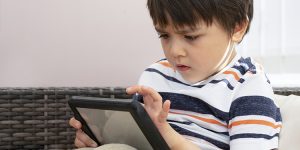ASSISTIVE TECHNOLOGY: SPECIAL FACTOR CONSIDERATIONS
Let us know about your experience on our site. Use the link below to submit your thoughts.
Assistive Technology
 Consideration of assistive technology (AT), in the context of IEP development, review, or revision is intended to be a collaborative process in which team members determine whether AT devices, supports, or services are needed for the learner with disabilities to:
Consideration of assistive technology (AT), in the context of IEP development, review, or revision is intended to be a collaborative process in which team members determine whether AT devices, supports, or services are needed for the learner with disabilities to:
- Be involved and progress in the Iowa Academic Standards, including the Iowa Essential Elements and the Iowa Early Learning Standards
- Progress toward the annual IEP goals
- Pursue a course of study and postsecondary expectations, or
- Participate in extracurricular and other nonacademic activities with learners with disabilities and nondisabled peers.
Consideration may necessitate that the IEP team include (or have access to) someone who has knowledge about AT or who can guide the team in considering AT in the context of what they know about the learner.
Consider areas where the learner relies on others and whether AT could help them be more independent. AT may be considered for mobility, hearing, vision, communication, computer access, reading, written language, positioning & seating, and recreation.
Assistive technology supports and devices may be simple, no-cost adaptations, built-in accessibility features, or high-tech equipment.
For each IEP developed, the team must consider and determine if assistive technology is a special factor that needs to be addressed for a learner.
The following questions may be helpful to IEP teams as they consider assistive technology:
Is there a specific task that is difficult for this learner? Would assistive technology support the learner with this task?
- The learner has difficulty communicating wants and needs.
- The learner struggles to follow auditory directions provided by the teacher only.
- The learner cannot access grade level content in reading or math.
- The learner’s writing is illegible.
- The learner is not able to write with the same speed or accuracy as peers.
- The learner shows evidence of listening fatigue such as distraction, frustration, exhaustion, or preferring to be alone in difficult listening situations.
- The learner cannot visually access print as written on the whiteboard/textbook/environment.
- The learner is not able to physically or visually access the environment. This may include the bus, lunchroom, classroom, hallways, desk/tables etc.
Is there a device, software, product or strategy that may allow the learner to perform this task with greater accuracy, ease or independence?
Examples of AT devices include:
Behavior – visual supports such as first/then chart
Communication – augmentative or alternative communication device (AAC), visual supports
Computer Access – adaptive keyboard, mouse pointer, larger monitor
Hearing – classroom amplification, captioning services, headphones
Math – calculator, digital graphing tools
Reading – graphic organizer, text reader, page fluffer
Seating & Mobility – gait trainer, walkers, positioning supports, cane (including adaptive mobility devices)
Vision – electronic braille display or notetaker, magnification including built-in options, screen reader
Written Language – pencil grip, word processing, dictation, speech-to-text
If the school district is using technology, hardware and/or software, for all learners in the classroom, the team should consider whether or not that technology is assistive technology for this learner. If, what the learner is using, increases, maintains or improves the learner’s functional performance, then it would be a special factor and documented within the learner’s IEP. In addition, if a family purchased a device and wants the learner to use it at school, the team should consider whether or not the device is assistive technology for the learner. If the device increases, maintains, or improves the learner’s functional performance, then it would be a special factor and documented within the learner’s IEP.
Does the learner require assistive technology for working or living?
Examples of assistive technology that may support living or working outcomes could include:
Text reader for job duties
Augmentative or alternative communication device (AAC)
Timer or App to for reminders
Magnification
If the IEP team answers NO to all questions, then the consideration process would stop. There would no longer be a need to consider the next section because ASSISTIVE TECHNOLOGY would NOT be a special factor.
Defining Assistive Technology Devices, Supports, and Services
Assistive Technology Supports
Examples of AT supports:
- Consulting on the needs of a learner with regard to assistive technology in the learner’s educational environment
- Selecting, designing, fitting, customizing, adapting, applying, maintaining, repairing, or replacing AT
- Purchasing, leasing, or otherwise providing for the acquisition of assistive technology
- Coordinating AT activities and services with other service providers
- Training opportunities for staff and families
- Providing aided language stimulation/modeling to learners who use augmentative/alternative communication (AAC)
- Troubleshooting technology and remediating problems
- Daily listening check performed on hearing assistive technology
Assistive Technology Services
AT services are generally not provided as a standalone service. Professionals may provide AT services in an integrated manner under their discipline-specific service (e.g. Speech Language Pathologist, Occupational Therapist, Physical Therapist, Teachers addressing unique needs of students with hearing or vision loss).
Assistive Technology Devices
Assistive Technology and AEM Resources
Further resources are available on the i3 special education resources page.
Additional resources are also available on the Iowa Department of Education Assistive Technology (AT) Page and Accessible Educational Materials (AEM) Page.